Related Research Articles

A battleship is a large armored warship with a main battery consisting of large caliber guns. During the late 19th and early 20th centuries the battleship was the most powerful type of warship, and a fleet centered around the battleship was part of the command of the sea doctrine for several decades. By the time of World War II, however, the battleship was made obsolete as other ships, primarily the smaller and faster destroyers, the secretive submarines, and the more versatile aircraft carriers came to be far more useful in naval warfare. While a few battleships were repurposed as fire support ships and as platforms for guided missiles, few countries maintained battleships after World War II, with the last battleships being decommissioned at the end of the Cold War.
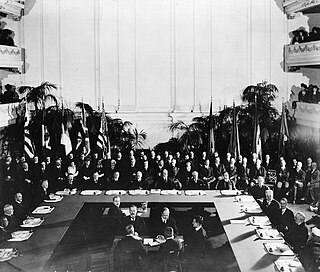
The Washington Naval Treaty, also known as the Five-Power Treaty, was a treaty signed during 1922 among the major Allies of World War I, which agreed to prevent an arms race by limiting naval construction. It was negotiated at the Washington Naval Conference, held in Washington, D.C., from November 1921 to February 1922, and it was signed by the governments of the United Kingdom, the United States, France, Italy, and Japan. It limited the construction of battleships, battlecruisers and aircraft carriers by the signatories. The numbers of other categories of warships, including cruisers, destroyers and submarines, were not limited by the treaty, but those ships were limited to 10,000 tons displacement each.

An armed merchantman is a merchant ship equipped with guns, usually for defensive purposes, either by design or after the fact. In the days of sail, piracy and privateers, many merchantmen would be routinely armed, especially those engaging in long distance and high value trade.

The Chilean Navy is the naval warfare service branch of the Chilean Armed Forces. It is under the Ministry of National Defense. Its headquarters is at Edificio Armada de Chile, Valparaiso.
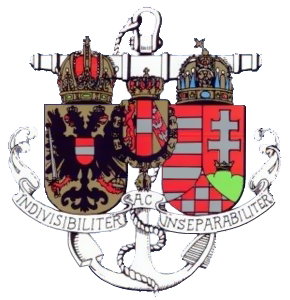
The Austro-Hungarian Navy or Imperial and Royal War Navy was the naval force of Austria-Hungary. Ships of the Austro-Hungarian Navy were designated SMS, for Seiner Majestät Schiff. Existing between 1867 and 1918, the k.u.k. Kriegsmarine came into being after the formation of Austria-Hungary in 1867, and ceased to exist upon the Empire's defeat and subsequent collapse at the end of World War I.
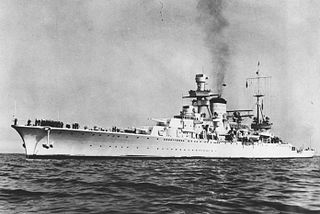
The two Veinticinco de Mayo-class heavy cruisers served in the Argentine Navy through World War II. They were the only post-Washington Naval Treaty heavy cruisers built for a South American navy. Both ships of the class were built in Italy by the OTO company, and commissioned into the Argentine Navy in 1931.

Minas Geraes, spelled Minas Gerais in some sources, was a dreadnought battleship of the Brazilian Navy. Named in honor of the state of Minas Gerais, the ship was laid down in April 1907 as the lead ship of its class, making the country the third to have a dreadnought under construction and igniting a naval arms race between Brazil, Argentina, and Chile.

ARA Moreno was a dreadnought battleship designed by the American Fore River Shipbuilding Company for the Argentine Navy. Named after Mariano Moreno, a key member of the first independent government of Argentina, the First Assembly, Moreno was the second dreadnought of the Rivadavia class, and the fourth built during the South American dreadnought race.

ARA Rivadavia was an Argentine battleship built during the South American dreadnought race. Named after the first Argentine president, Bernardino Rivadavia, it was the lead ship of its class. Moreno was Rivadavia's only sister ship.

The Rivadavia class consisted of two battleships designed by the American Fore River Shipbuilding Company for the Argentine Navy. Named Rivadavia and Moreno after important figures in Argentine history, they were Argentina's entry in the South American dreadnought race and a counter to Brazil's two Minas Geraes-class battleships.
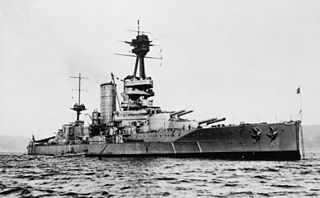
Almirante Latorre, named after Juan José Latorre, was a super-dreadnought battleship built for the Chilean Navy. It was the first of a planned two-ship class that would respond to earlier warship purchases by other South American countries. Construction began at Elswick, Newcastle upon Tyne soon after the ship was ordered in November 1911, and was approaching completion when it was bought by the United Kingdom's Royal Navy for use in the First World War. Commissioned in September 1915, it served in the Grand Fleet as HMS Canada for the duration of the war and saw action during the Battle of Jutland.

The Almirante Latorre class consisted of two super-dreadnought battleships designed by the British company Armstrong Whitworth for the Chilean Navy. They were intended to be Chile's entries to the South American dreadnought race, but both were purchased by the Royal Navy prior to completion for use in the First World War. Only one, Almirante Latorre (HMS Canada), was finished as a battleship; Almirante Cochrane (HMS Eagle), was converted to an aircraft carrier. Under their Chilean names, they honored Admirals (Almirantes) Juan José Latorre and Thomas Cochrane; they took their British names from the dominion and a traditional ship name in the Royal Navy.

The Minas Geraes class, spelled Minas Gerais in some sources, consisted of two battleships built for the Brazilian Navy in the early twentieth century. Named Minas Geraes and São Paulo, the ships were intended to be Brazil's first step towards becoming an international power, and they consequently initiated a South American naval arms race.

A fin flash is part of the national markings of the military aircraft of a number of countries.

A naval arms race among Argentina, Brazil and Chile—the most powerful and wealthy countries in South America—began in the early twentieth century when the Brazilian government ordered three dreadnoughts, formidable battleships whose capabilities far outstripped older vessels in the world's navies.
An arms race occurs when two or more nations compete in increases in military personnel and materiel. Simply defined as a competition between two or more states to have superior armed forces; a competition concerning production of weapons, the growth of a military, and the aim of superior military technology. The term is also used to describe any long-term escalating competitive situation where each competitor focuses on out-doing the others.

Capitán Prat was a unique ironclad battleship of the Chilean Navy built in the late 1880s and completed in 1890. Armed with a main battery of four 9.4 in (240 mm) guns in four single turrets, Capitán Prat was the first battleship in the world to be equipped with an electrical system. She was built in the La Seyne dockyard in France, and commissioned into the Chilean fleet in 1891. Foreign navies tried to purchase the ship twice before the outbreak of wars, including an American attempt in 1898 and a Japanese offer in 1903.

In the late nineteenth and early twentieth centuries, the South American nations of Argentina and Chile engaged in an expensive naval arms race to ensure the other would not gain supremacy in the Southern Cone.

A naval arms race between the Austrian Empire and Italy began in the 1860s when both ordered a series of ironclad warships, steam-propelled vessels protected by iron or steel armor plates and far more powerful than all-wood ships of the line. These ships were constructed to establish control over the Adriatic Sea in the event of a conflict between the two countries.
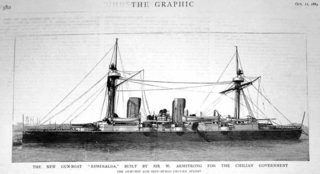
The Chilean cruiser Esmeralda was the first modern protected cruiser, a ship type named for the arched armored deck that protected its most vital areas, including its propulsion plant and magazines.